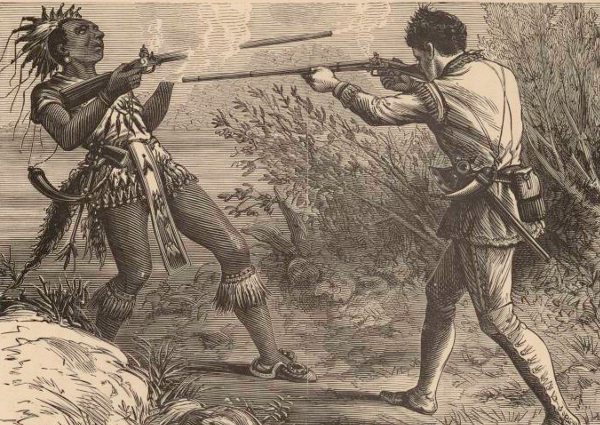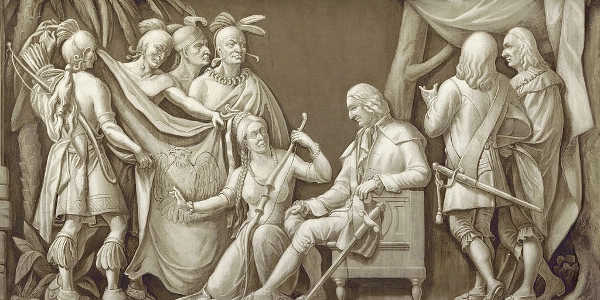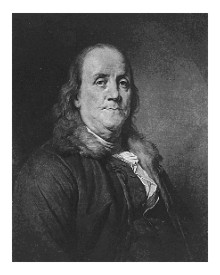-
Pre-Revolution Timeline - 1720-1739
It's a time for books, libraries, religious ideas, and more colonies for New France and England, which brought more wars between rivals seeking supremacy.
More 1700s
Sponsor this page for $150 per year. Your banner or text ad can fill the space above.
Click here to Sponsor the page and how to reserve your ad.
-
Timeline
-
More
-
More
-
More
-
More
-
More
-
More
-
More
-
More
-
More
-
More
-
More
-
More
-
More
-
More
1720-1729
May 1720 - French fur traders build Le Magazin Royale, a trading post along the Niagara River that would become Fort Niagara, the strategic New France garrison protecting their interests along Lake Ontario and the western frontier.
June 16, 1720 - The Villasur expedition of Spanish troops leaves Mexico on a mission to control the increasing presence of the French in the Great Plains. It would end with a defeat by the Pawnee on August 14 near the Loup and Platte Rivers, near Columbus, Nebraska.
January - September, 1720 - Stock prices in the Mississippi Company of John Law with exclusive trading rights in the New France colony of Louisiana and the Mississippi River collapses in the Mississippi Bubble.
March 29, 1721 - Adrien de Pauger arrives in New Orleans to design plans for the city and French Quarter throughout the year.
July 25, 1722 - Declaration of war occurs in Dummer's War after skirmishes earlier in the year between New England colonists and the Wabanaki Confederacy, backed by New France. Lasted three years until December 15, 1725.
May 9, 1725 - Battle of Pequawket in Dummer's War leads to peace treaties between the colonies of New England and the Indian allies of New France in 1725-7.
1727 - British establish presence on the Great Lakes with the construction of Fort Oswego on the southeast shore of Lake Ontario at the site of an 18th century trading post, to counter the New France garrison at Fort Niagara.
July 25, 1729 - Lord proprietors sells out their interests in North Carolina to British Crown, establishing North Carolina as a Crown Colony.
October 2, 1729 - Benjamin Franklin buys an interest in the Pennsylvania Gazette, founded one year earlier by Samuel Keimer.
1729 - The Mathematical Principles of Natural Philosophy by Sir Isaac Newton is translated into English for the first time.
1730-1739
July 1, 1731 - Benjamin Franklin begins the Library Company of Philadelphia through the Junto, or Leather Apron Club, a discussion group for business interests and mutual improvement.
July 8, 1731 - Public lecture in Boston by Jonathan Edwards, later published as "God Glorified in the Work of Redemption, by the Greatness of Man's Dependence upon Him, in the Whole of It," leads to the movement of the First Great Awakening.
February 22, 1732 - George Washington is born in
Westmoreland County, Virginia.
April 21, 1732 - Province of Georgia corporate charter granted to General James Oglethorpe by British King George II with original western border of the Pacific Ocean and settlers who had been imprisoned for their debts.
December 28, 1732 - Poor Richard's Almanac is published for the first of its twenty-six annual editions by Benjamin Franklin in Philadelphia. It would sell as many as 10,000 copies per year.
April 1733 - Sir Richard Wampole fails to change the import taxation system after widespread protest from a tax on imports at custom houses to an excise tax in the English Excise Crises.
January 9, 1735 - House of Commons in the English Parliament agrees with James Oglethorpe to ban slavery in the Province of Georgia. Ban would last for sixteen years.
August 4, 1735 - Freedom of the Press became recognized in New York after the trial of John Peter Zenger, who had been accused of libeling the British Government in his Weekly Journal. Zenger was acquitted on that date.
May 7, 1738 - Anglican minister George Whitefield arrives for his first of seven visits to North America and becomes the predominant preacher in the First Great Awakening movement throughout the colonies.
September 9, 1739 - The last major slave rebellion in the mainland colonies of English, the Stono Rebellion, begins in South Carolina.
History Photo Bomb

Engraving of Chamberlain and Paugus at Lovewell's Fight, Dummer's War, 1872, Author Unknown, John Gilmary Shea's A Child's History of the United States. Courtesy Wikipedia Commons.
Timeline Book

Old Fort Niagara, 1900, Detroit Photographic Company. Courtesy Library of Congress.
ABH Travel Tip
Be fort centric! Yes, if you like forts, there's plenty to go around. You can visit Fort Ticonderoga, above, in New York, or the forts of San Francisco, there's one, Fort Point, beneath the Golden Gate bridge, or anywhere in between, whether your interest is frontier, wild west, or Civil War.
About
America's Best History where we take a look at the timeline of American History and the historic sites and national parks that hold that history within their lands.
Photos courtesy of the Library of Congress, National Archives, National Park Service, americasbesthistory.com & its licensors.
- Contact Us
- About
- © 2024 Americasbesthistory.com.
Template by w3layouts.



